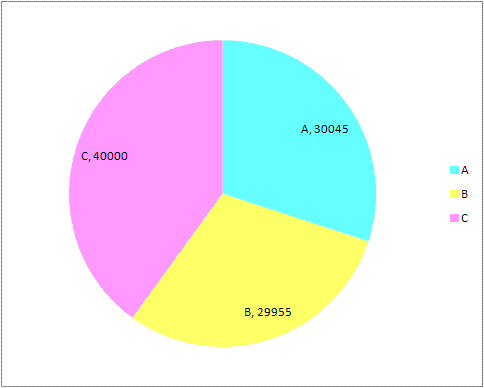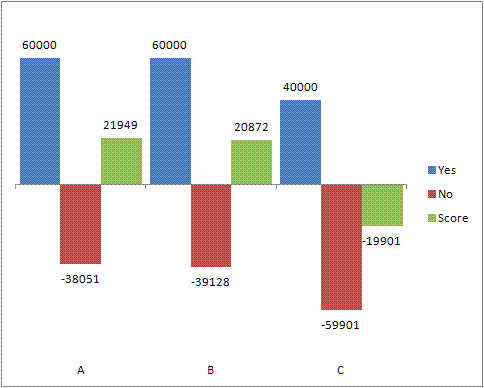

Plurality Voting - A Pie Chart
- Votes are disjoint* to each other.
- Candidate's score is his vote total.
- Candidates compete for the same votes.
- Negative campaigning works to steal votes.
- Unfairly favors the most unique candidate.
- * Disjoint is the Finite Mathematics term for events that can't happen together.
Independent Voting - A Column Chart
- Votes are independent* to each other.
- Candidate's score is his YES minus his NO.
- Candidates get their own separate votes.
- Negative campaigning does not work.
- Does not unfairly favor any candidate.
- * Independent is the Finite Mathematics term for events that don't affect each other.
The sample scenario:
- The Proposition X vote is unfairly split among candidates A & B.
- Candidate C wins.
- Proposition X is unfairly defeated.
- The will of the people is thwarted
The sample scenario:
- The Proposition X vote is not split between candidates A and B.
- Candidate A wins.
- Proposition X is not defeated.
- The will of the people is preserved
Properties of plurality voting:
- Vote for only one candidate in each race.
- Unfairly favors the candidate most different from the others.
- Unfairly disfavors candidates similar to other candidates.
- Lets candidates steal votes from others with negative campaigns.
- Lets the press steal votes with negative stories and campaigns.
- Some candidate votes have more power than votes for others.
- Voters are split among multiple candidates with similar platforms.
- Voters who don't like any of the candidates are disenfranchised.
- Voters who like more than one candidate are disenfranchised.
- The system is biased for some candidates and against others.
- The system is biased when more than two candidates run.
- Candidates joining or leaving the race can change the outcome.*
- This is why signatures or petitions are needed to get on the ballot.
- * Not counting the case where the entering candidate wins.
- Usually chooses the candidate most different from the others.
- Candidates running can hurt each other, so primaries are necessary.
- Recounts are required when a tie or near tie occurs.
- No runoff election is allowed.
- Overvotes (voted for too many) disqualify ballots.
- Undervotes (didn't vote for any) are not counted.
- Voters are often kept from voting their consciences.
- Voters often have to abandon favorites to stop their worst choices.
- Is used for unfair at-large elections.
- Can be used for fair yes-no referendum elections.
- Is used in an unfair form of electoral voting.
- Is used in an unfair form of proportional representation voting.
- The system has no way to eliminate nonlegislative offices.
- Works on any ballot type: paper, machine, computer, or mark-sense.
- Congress uses it for multiple-choice votes.
Properties of independent voting:
- Vote for or against every candidate in each race.
- Fairly treats all candidates exactly the same. Has no bias.
- Allows voters to vote for all similar candidates.
- Candidates can't use negative campaigning to steal votes.
- The press can't use negative campaigning to steal votes.
- Each voter has exactly the same voting power.
- Voters are not split by multiple similar candidates.
- Voters who dislike all of the candidates aren't disenfranchised.
- Voters who like multiple candidates are not disenfranchised.
- The system has no bias for or against any candidate.
- The number of candidates running does not matter.
- Candidates joining or leaving the race can't change the outcome.*
- No signatures or petitions are necessary to get on the ballot.
- * Not counting the case where the entering candidate wins.
- Always chooses the choice that pleases the most voters.
- Candidates can't hurt each other, so primaries are unnecessary.
- No recounts are allowed.
- Runoffs occur if there is a tie (rare) or no positive score exists.
- There is no such thing as an overvote.
- There is no such thing as an undervote.
- Voters can always vote their consciences.
- Voters don't have to abandon favorites to stop their worst choices.
- Can be used for at-large elections (but at-large itself isn't fair).
- Can be used for fair referendum elections.
- Can be used in a fair form of electoral voting.
- Can be used in a fair form of proportional representation voting.
- Can have a way to eliminate nonlegislative offices built into it.
- Works on any ballot type: paper, machine, computer, or mark-sense.
- Congress uses it for its internal votes (sort of).
- Plurality Voting does not refute Arrow's Theorem.
Arrow's Theorem: "No voting system satisfies all fairness criteria."
- Many fairness criteria are wrongly based on ranking, which itself is unfair.
- Independent Voting refutes Arrow's Theorem.
Arrow's Theorem: "No voting system satisfies all fairness criteria."
- Independent Voting satisfies all reasonable fairness criteria because it doesn't use ranking.
- Plurality Voting doesn't refute the Gibbard-Satterthwait Theorem.
Gibbard-Satterthwait Theorem: "No voting system is immune to insincere voting."
- People vote so that their side, rather than their candidate, wins.
- People often vote to keep the worst candidate out.
- Independent Voting refutes The Gibbard-Satterthwait Theorem.
Gibbard-Satterthwait Theorem: "No voting system is immune to insincere voting."
- Insincere (strategic) voting is useless with Independent Voting because choices are voted on independently.